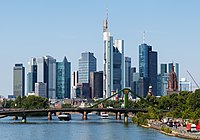The Empire State Building is a 102-story Art Deco skyscraper in the Midtown South neighborhood of Manhattan in New York City. The building was designed by Shreve, Lamb & Harmon and built from 1930 to 1931. Its name is derived from "Empire State", the nickname of the state of New York. The building has a roof height of 1,250 feet (380 m) and stands a total of 1,454 feet (443.2 m) tall, including its antenna. The Empire State Building was the world's tallest building until the first tower of the World Trade Center was topped out in 1970; following the September 11 attacks in 2001, the Empire State Building was New York City's tallest building until it was surpassed in 2012 by One World Trade Center. As of 2024, the building is the seventh-tallest building in New York City, the ninth-tallest completed skyscraper in the United States, and the 57th-tallest completed skyscraper in the world.

Kingdom Centre, formerly Kingdom Tower, is a 41-story, 302.3 m (992 ft) skyscraper in the al-Olaya district of Riyadh, Saudi Arabia. When completed in 2002, it overtook the 267-meter (876 ft) Faisaliah Tower as the tallest tower in Saudi Arabia. It has since been surpassed and, as of 2021, is the fifth-tallest skyscraper in the country, whose tallest two buildings are the The Clock Towers and the Capital Market Authority Tower. It is the world's third-tallest building with a hole after the Shanghai World Financial Center and the 85 Sky Tower in Taiwan. It contains the King Abdullah Mosque, which is the world's most elevated mosque from ground level.

The Standard Bank Centre is a skyscraper in Johannesburg, South Africa. It is located at the corner of 27 Simmonds Street and 78 Fox Street in the Central Business District of the city. Construction of the building started in 1966 and was completed in 1968. It is 139 m (456 ft) tall. It was also home to Standard Bank, until the company moved to a new site in 1990.

The Federation Tower is a complex of two skyscrapers built on the 13th lot of the Moscow International Business Center in Moscow, Russia. The two skyscrapers are named Tower East or Vostok and Tower West or Zapad.

One North Wacker, UBS Tower is a 50-story skyscraper at One North Wacker Drive in downtown Chicago, Illinois. The tower was built from 1999 to 2002 to accommodate Swiss investment bank UBS AG's Chicago headquarters. Originally UBS Tower, as it was solely known then, housed four different branches of the bank including its investment banking, wealth management advisory, asset management, and private banking businesses.

Mercury City Tower is a supertall skyscraper located on plot 14 in the Moscow International Business Center (MIBC), in Moscow, Russia. Occupying a total area of 173,960 square metres (1,872,500 sq ft), the mixed-use building houses offices, apartments, a fitness center, and retail stores.
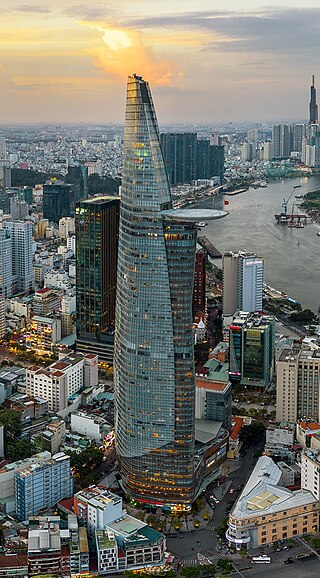
Bitexco Financial Tower is a skyscraper in Ho Chi Minh City, Vietnam. At its completion in 2010, it became the tallest building in Vietnam and kept this status until January 2011, when it was surpassed by Keangnam Hanoi Landmark Tower. With 68 floors above ground and three basements, the building has a height of 262.5 metres (861 ft), making it the second tallest building in the city, fourth tallest in Vietnam, and the 412th tallest in the world, as of May 2022.
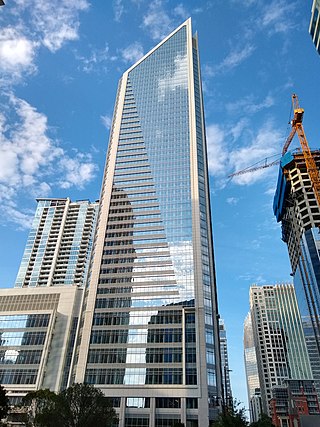
550 South Tryon is a 786-foot (240 m) tall, 48-floor skyscraper in Charlotte, North Carolina.

Shanghai Tower is a 128-story, 632-meter-tall (2,073 ft) megatall skyscraper located in Lujiazui, Pudong, Shanghai. It is the tallest building in China and the world's third-tallest building by height to architectural top. It is the tallest and largest LEED Platinum certified building in the world since 2015. It had the world's fastest elevators at a top speed of 20.5 meters per second until 2017, when it was surpassed by the Guangzhou CTF Finance Center, with its top speed of 21 meters per second. Designed by the international design firm Gensler and owned by the Shanghai Municipal Government, it is the tallest of the world's first triple-adjacent supertall buildings in Pudong, the other two being the Jin Mao Tower and the Shanghai World Financial Center. Its tiered construction, designed for high energy efficiency, provides nine separate zones divided between office, retail and leisure use. The US-based Council on Tall Buildings and Urban Habitat cites it as "one of the most sustainably advanced tall buildings in the world."

F5 Tower is a 660-foot-tall (200 m) skyscraper in Downtown Seattle, Washington. It consists of 44 floors and is the sixth-tallest building in Seattle.

The AIA Tower, formerly the Philamlife Tower, is an office skyscraper located in Makati, Philippines. It is owned and developed by Philam Properties Corporation, the real estate arm of the Philippine American Life and General Insurance Company. Standing at 200 meters (660 ft), it is currently the 7th-tallest building in Makati, and is the 14th-tallest building in the country and Metro Manila as well. The building has 48 floors above ground, and 5 basement levels for parking. It is also the current headquarters of AIA Philippines since 2023, which was renamed to AIA Tower.

Sede do BankBoston is a 35-story skyscraper in São Paulo, Brazil. The structure is a great office skyscraper located in Brooklin, near the Marginal Pinheiros, São Paulo, Brazil. Inaugurated in 2002, it is 145 meters in height and has 35 floors, making it one of the largest in the country and one of the more modern high-rises in Latin America. In 2006, the building was sold to Banco Itaú, prior to which time BankBoston company had merged with Fleet Bank, and ceased to exist as a separate entity. Today, some people call it an Edifício Itaú Bank.

Union Square is a skyscraper complex at Sixth Avenue between Union and University Streets in Downtown Seattle, Washington, adjacent to Freeway Park. It consists of two skyscrapers built in the 1980s and primarily used for office space. The entire complex features a 1,100-stall parking garage, a courtyard, a retail plaza spanning three stories and an underground pedestrian concourse that connects with the Fifth Avenue Theater and Rainier Square. Both structures were awarded LEED certification in 2009 and eventually received LEED Platinum certification 6 years later as a result of reduced annual energy consumption by 40 percent through recent renovations. The entire complex is currently managed by Washington Holdings, a real estate firm also known as Union Square LLC which is based in Seattle.
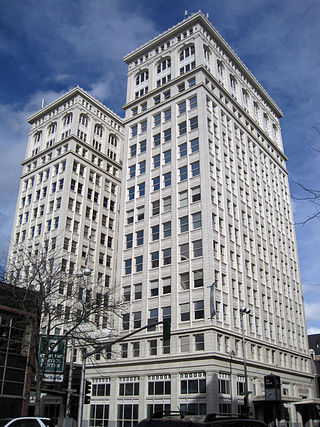
The U.S. Bank Building, previously the Old National Bank Building, is a high-rise in Spokane, Washington, United States. Having been completed in 1910, it was the first skyscraper in the Inland Northwest. At 219 ft (67 m) tall, the building was the tallest in the state of Washington from 1910 to 1911, when it was surpassed by the Key Bank Center in Tacoma—which itself was far surpassed by Seattle's Smith Tower in 1914. It remained the tallest building in Spokane, until the 1929 completion of the Paulsen Medical and Dental Building, located across the street.
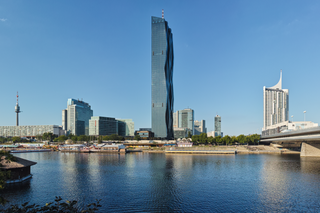
The DC Towers also known as the Donau City Towers is a mixed-use skyscraper complex in Vienna's District Donaustadt. The towers are designed by French architect Dominique Perrault. Werner Sobek AG was responsible for the structural engineering as well as the facade and height access planning of DC Tower 1.

Helmut Hentrich was a German architect who became particularly known for his striking high-rise buildings in the 1960s and 1970s. The architectural firm he founded, Hentrich, Petschnigg und Partner (HPP), still exists under the name HPP Architekten.

The Antwerp Tower is a skyscraper in Antwerp (Belgium). Originally built in 1974 with a height of 87 m (285 ft), the Antwerp Tower was the third-tallest building in Antwerp, behind the Cathedral of our Lady and the Boerentoren. After the completion of an extensive renovation in 2019-2021, where two double-height floors were added, the Antwerp Tower is now the second-tallest building in the city overall and the highest residential building, with a height of 100.70 m (330.4 ft).

The Business Tower Nürnberg is a high-rise office building in Nürnberg, Germany. Built between 1996 and 2000, the tower stands at 135 m (443 ft) tall with 35 floors and is the current tallest building in Nuremberg and the first 100 meters high-rise building in the city, as well as the 35th tallest in Germany.

The City Tower Offenbach is a high-rise office building in the Mathildenviertel district of Offenbach am Main, Germany. Built between 2001 and 2003, the tower stands at 120 m (390 ft) tall with 32 floors and is the current 48th tallest building in Germany and the tallest in Offenbach.

The Florido Tower also known as the Peak Vienna is a high-rise office building in the Floridsdorf district of Vienna, Austria. Built between 1999 and 2001, the tower stands at 113 m (371 ft) tall with 31 floors and is the current 13th tallest building in Austria.























